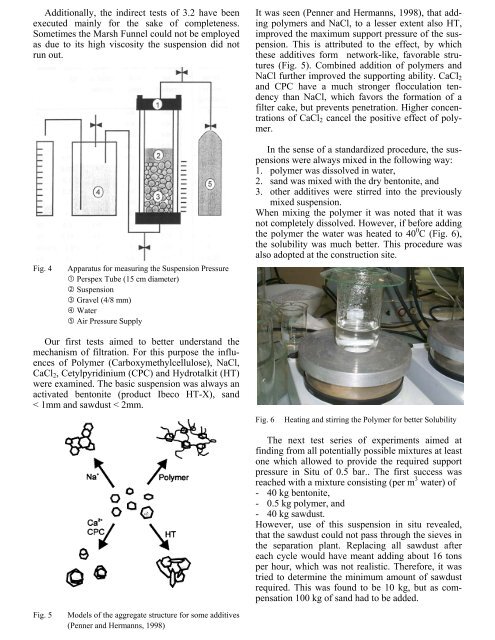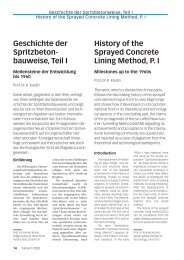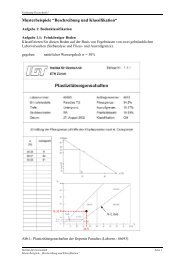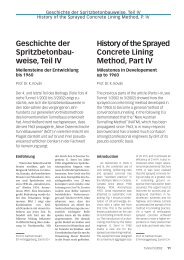Modified Bentonite Slurries for Slurry Shields in Highly ... - ETH - IGT
Modified Bentonite Slurries for Slurry Shields in Highly ... - ETH - IGT
Modified Bentonite Slurries for Slurry Shields in Highly ... - ETH - IGT
Create successful ePaper yourself
Turn your PDF publications into a flip-book with our unique Google optimized e-Paper software.
Additionally, the <strong>in</strong>direct tests of 3.2 have been<br />
executed ma<strong>in</strong>ly <strong>for</strong> the sake of completeness.<br />
Sometimes the Marsh Funnel could not be employed<br />
as due to its high viscosity the suspension did not<br />
run out.<br />
It was seen (Penner and Hermanns, 1998), that add<strong>in</strong>g<br />
polymers and NaCl, to a lesser extent also HT,<br />
improved the maximum support pressure of the suspension.<br />
This is attributed to the effect, by which<br />
these additives <strong>for</strong>m network-like, favorable strutures<br />
(Fig. 5). Comb<strong>in</strong>ed addition of polymers and<br />
NaCl further improved the support<strong>in</strong>g ability. CaCl 2<br />
and CPC have a much stronger flocculation tendency<br />
than NaCl, which favors the <strong>for</strong>mation of a<br />
filter cake, but prevents penetration. Higher concentrations<br />
of CaCl 2 cancel the positive effect of polymer.<br />
Fig. 4<br />
Apparatus <strong>for</strong> measur<strong>in</strong>g the Suspension Pressure<br />
Perspex Tube (15 cm diameter)<br />
Suspension<br />
Gravel (4/8 mm)<br />
Water<br />
Air Pressure Supply<br />
In the sense of a standardized procedure, the suspensions<br />
were always mixed <strong>in</strong> the follow<strong>in</strong>g way:<br />
1. polymer was dissolved <strong>in</strong> water,<br />
2. sand was mixed with the dry bentonite, and<br />
3. other additives were stirred <strong>in</strong>to the previously<br />
mixed suspension.<br />
When mix<strong>in</strong>g the polymer it was noted that it was<br />
not completely dissolved. However, if be<strong>for</strong>e add<strong>in</strong>g<br />
the polymer the water was heated to 40 0 C (Fig. 6),<br />
the solubility was much better. This procedure was<br />
also adopted at the construction site.<br />
Our first tests aimed to better understand the<br />
mechanism of filtration. For this purpose the <strong>in</strong>fluences<br />
of Polymer (Carboxymethylcellulose), NaCl,<br />
CaCl 2 , Cetylpyrid<strong>in</strong>ium (CPC) and Hydrotalkit (HT)<br />
were exam<strong>in</strong>ed. The basic suspension was always an<br />
activated bentonite (product Ibeco HT-X), sand<br />
< 1mm and sawdust < 2mm.<br />
Fig. 6<br />
Heat<strong>in</strong>g and stirr<strong>in</strong>g the Polymer <strong>for</strong> better Solubility<br />
The next test series of experiments aimed at<br />
f<strong>in</strong>d<strong>in</strong>g from all potentially possible mixtures at least<br />
one which allowed to provide the required support<br />
pressure <strong>in</strong> Situ of 0.5 bar.. The first success was<br />
reached with a mixture consist<strong>in</strong>g (per m 3 water) of<br />
- 40 kg bentonite,<br />
- 0.5 kg polymer, and<br />
- 40 kg sawdust.<br />
However, use of this suspension <strong>in</strong> situ revealed,<br />
that the sawdust could not pass through the sieves <strong>in</strong><br />
the separation plant. Replac<strong>in</strong>g all sawdust after<br />
each cycle would have meant add<strong>in</strong>g about 16 tons<br />
per hour, which was not realistic. There<strong>for</strong>e, it was<br />
tried to determ<strong>in</strong>e the m<strong>in</strong>imum amount of sawdust<br />
required. This was found to be 10 kg, but as compensation<br />
100 kg of sand had to be added.<br />
Fig. 5<br />
Models of the aggregate structure <strong>for</strong> some additives<br />
(Penner and Hermanns, 1998)






